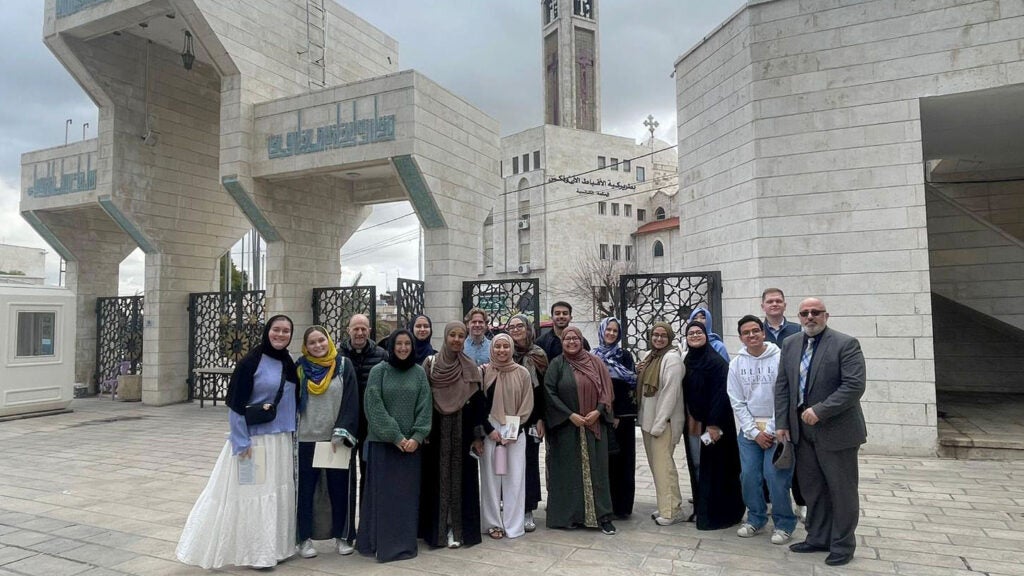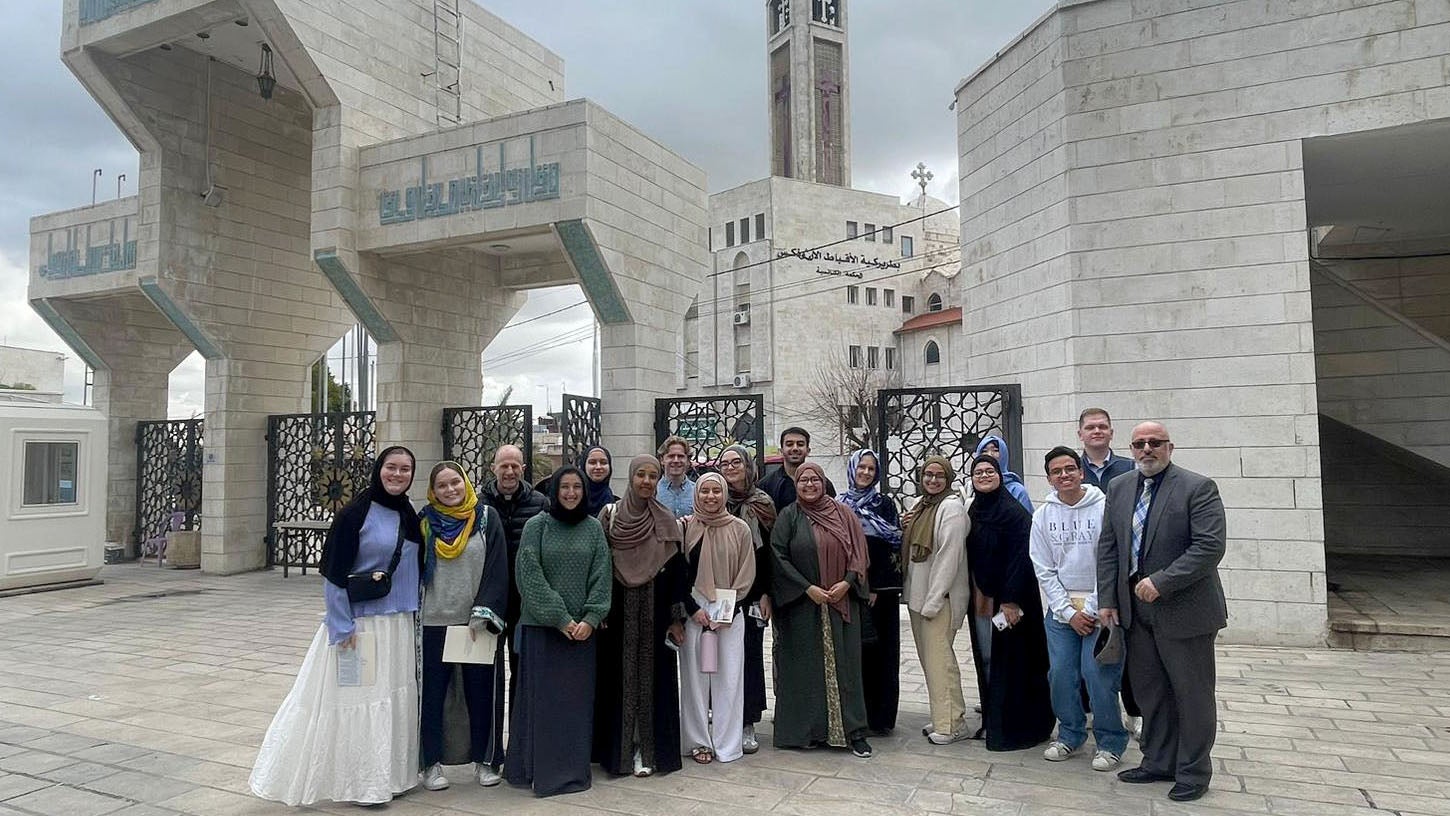Women in Faith: Dr. Ryann Craig
After a pivot in the face of a crisis, Dr. Ryann Craig leads a Magis Seminar through interreligious dialogue by understanding cultural context with compassion.
By Jennon Bell Hoffman

Students and faculty on Georgetown’s Magis Immersion trip to Jordan, pictured in front of King Abdullah I Mosque in the heart of Amman, Jordan.
“Context is everything,” said Alvin Ward Gouldner, a sociologist in 1955, when explaining the how nature of knowledge is bound by the history of its time. Few can understand this as acutely as Dr. Ryann Craig. As the Special Assistant to the Vice President for Mission and Ministry & Director for Academic Initiatives, as well as Assistant Research Professor, Dr. Craig uses her academic expertise in ancient texts to bridge present-day issues with her students. She recently chatted with us as part of our Women in Faith series to learn more about cultural context in the face of modern issues.
Campus Ministry: Speaking of context, tell us how you found yourself at Georgetown.
Dr. Ryann Craig: In October of 2019, I came to Georgetown after finishing my PhD at Catholic University and I started at the Berkley Center for Religion, Peace and World Affairs. That was my first home at Georgetown, overseeing student programming and doing some faculty development, and really working at the intersection of International Affairs and religion—how religion affects people’s lives and how they make decisions. And that was something I was really interested in because my background, my PhD, is in the Eastern Christian communities and their engagement with Islam in the early historical period.

Dr. Ryann Craig, special assistant to the vice president for mission and ministry and director of academic initiatives, and assistant research professor at Georgetown.
I’m much more historically focused as a scholar, but because I am also a practicing Christian—a practicing Anglican—I’ve been involved in actual interfaith dialogue my whole life, bringing together what contemporary concerns are in the world when it comes to interreligious dialogue. My role at the Berkley Center gave me a lot of avenues to really make connections across the university and that’s how I ended up where I am now.
CM: You recently co-led the Magis Immersion trip to Jordan with Imam Hendi, director for Muslim Life, and Fr. Matt Carnes, S.J, the vice dean for faculty and graduate affairs for the School of Foreign Service. Tell me more about that experience as a leader. What was it like seeing students experience this part of the world through the Christian-Muslim lens?
RC: This was my first Magis trip, though not my first trip with students. The class was originally designed around Jerusalem and was going to be co-taught with Imam Hendi and our Rabbi [Rabbi Daniel Schaefer, interim director for Jewish Life] and I was asked to be the faculty of record because I lived in Jerusalem for two years while I was working on my dissertation. I had some lived experience there and had been involved in Christian-Muslim-Jewish dialogue while I lived there. Then obviously, we had to pivot after October 7, and though I had never been to Jordan, I knew that Imam Hendi had spent time there and had connections there and I also felt very comfortable in terms of the culture and understanding the cultural context. I was confident that it would be a different but good experience.
CM: What was the experience in Jordan like?
RC: It’s really hard to put into words. It was probably the most meaningful place I have been an educator, if that makes sense. I was learning so much alongside the students.
Actually, there are things that bother me a little about experiential learning—the access barriers, the ecological impact, for example—but watching the students learn on the ground was so incredible that I really understand the value of that and I fully support immersive programs. Especially programs that are about interreligious engagement. I don’t know how else you can get that without going into it.
It is a different context in Jerusalem, where you have multiple religious communities living side by side, whereas in Jordan it’s not as pronounced because, for the most part, Christians are very integrated into Jordanian society. There’s no distinctive “Christian-Muslim dialogue.” It’s more just a lived reality for them.

A view of the Coptic Orthodox Patriarchate from the King Abdullah I Mosque, symbolically representing the overlapping histories and cultures of Jordan.
CM: What was it like for you to be in such an ancient place that has centuries of history, records, overlapping ideologies, and context, and share that with the students?
RC: I think that more of the interreligious interactions came out when we were visiting historical sites, where we saw where the communities overlapped historically was not necessarily points of tension, but just where you could see it more clearly.
And it really parallels well with what I study in the historical context, the Eastern Christian communities, which are the communities that existed alongside Islam in the very early period. And you do see that they’re culturally together, that it’s a shared culture. It’s a shared linguistic and artistic culture but then also a shared theological culture. Even within Palestinian culture, there’s so much shared commonality that there’s a deep identification, even among Christians in the region, that they’re very, very close to their Muslim counterparts. I think that was remarkable, and so fascinating to have the students get that, to see that on the ground now.
CM: Considering the current crisis in Gaza and how directly it affected the Magis Immersion Seminar plan, how did you decide to approach the curriculum for your trip? How do you begin to help students make sense of all that has happened, and is happening?
RC: I think one of the things that I go back to is the foundation for Ignatian pedagogy is the context—context is the foundation. And so, understanding and starting with the context of what that means in Jordan, which was our starting place, was understanding what that means for Jordanian society, what does it mean that they absorbed refugees in ‘48? What does it mean that they absorbed more refugees in ’67? And what does that context look like now? And those were conversations that we were having throughout the course, throughout the lead up to the trip, bringing in people who could speak to those historical events and that context, but then also speak to the present context too. That’s really how we tried to shape those conversations around what that means for what’s happening right now in Gaza. What does that look like in Jordanian society, and then what does that mean in terms of Jordanian relationships with what’s happening?
There are complicating layers—there’s the fact that there are so many Jordanians of Palestinian descent. There are complicated layers of Jordanian relations with the US and with Israel. And what does that mean for Jordan to play that role? And how, like how Jordanians might be critical, Americans may be critical. At the same time, there is an element of stability that they offer in the region that no other country can offer. So we talked about all those different layers and factors.

(left to right) Fr. Matt Carnes, S.J., Dr. Ryann Craig and Imam Yahya Hendi in front of the Church of St. George, home of the oldest mosaic map of the Holy Land, Madaba, Jordan.
CM: Understanding and applying context—historical and current—is a keystone to your teaching approach. Can you tell me more about your style and approach to teaching?
RC: [In school], I grew up in a culture of the expert at the top [of the classroom] and they’re just telling you everything, and you, the student, are just absorbing and taking notes. And that was fine for me in terms of learning—I learned really well. But I do remember one thing, and I think I bring this more into my work here than I realized. I remember when my dad dropped me off for undergrad, he said, “If the only thing you learn is in the classroom, I’ll be disappointed.” Wow. And I was like, “Okay. I will take advantage of learning.” And I think that shaped how I teach in the classroom too. It’s not just the knowledge that I’m imparting, but the conversations that we have as a class. That is actually more meaningful long term, and it helps students grow and sets the stage for being a lifelong learner.
I want them to be curious about learning. I am a big proponent of upgrading methods and models of engagement where they can determine what they want to get out of something [the course, an assignment, etc.]. I try to use those not only within my classroom space but that’s also sort of building that culture of curiosity and being able to ask questions that are beyond just the facts.
CM: What does women and faith at Georgetown mean for you?
RC: When I think about women in faith at Georgetown, I think about some of the relationships that I’ve been able to develop with women colleagues around how our faith shapes how we engage with our work. I think those are so rare in higher ed and more meaningful in ways that I can’t even begin to express how valuable they are. It’s really what grounds me and roots me in my work here. And having those conversations, having those touch points with others, whatever their background, it’s that shared understanding that we’re approaching our work through this lens of our lived faith, having a shared value of approaching our work through the lens of faith and vocation.
It’s hard to put into words how valuable that is in the context of a work environment, that there’s a shared understanding that you are a person of faith; that we can do that in a way that is so free and open and not weird, it’s really special to me and to have that here on campus.
I think there’s a freedom here to bring your whole self into the work that doesn’t necessarily exist in other spaces, even other Catholic institutions. I didn’t always feel like I was able to bring my full self into relationships with colleagues or relationships with students. There’s an authenticity to what I’m doing because they know that I actually live this and practice it. Because I’m open about sharing that and then it opens up opportunities for conversations that I think are more meaningful in the classroom, that they’re not necessarily getting in other ways. It’s really special. That’s one of the things that I value the most about being here.
Jennon Bell Hoffmann is a freelance writer and editor living in Chicago.
Photos courtesy of Dr. Ryann Craig.
